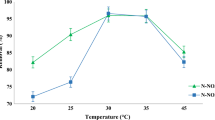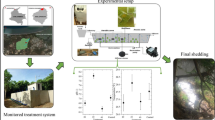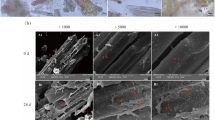Abstract
Wastewater from shrimp farming is rich in organic material, solids, and nutrients, which cause a series of environmental problems when released into the environment. Currently, for the removal of nitrogen compounds from wastewater, among the most studied methods is biological denitrification. The objective of this study was to evaluate the operational parameters for the development of a more sustainable technology for the removal of nitrogen compounds from shrimp farm wastewater, using Bambusa tuldoides (a species of bamboo) as a source of carbon and a material conducive to the development of selected denitrifying bacteria. To optimize the process, biological denitrification assays were performed varying the following parameters: bamboo length (cm), pH, temperature, and stoichiometric proportions of C and N. The operational stability of the process with the reuse of the bamboo biomass was also evaluated. Cronobacter sakazakii and Bacillus cereus were identified as denitrifying microorganisms present in reactor with bamboo biomass. The best operational conditions observed were pH 6 to 7 and temperature 30 to 35 °C, and the addition of an external carbon source was not necessary for the denitrification process to occur efficiently. Under these conditions, biological denitrification occurred with an average efficiency above 90% based on the removal of the nitrogen contaminants evaluated (NO3˗N and NO2-N). Regarding operational stability, 8 cycles were performed using the same source of carbon without reducing the efficiency of the process.







Similar content being viewed by others
Data availability
The dataset utilized/analyzed during the current study will be available from the corresponding author upon request.
References
APHA (2012) Standard Methods for the examination of water and wastewater (22nd ed). Washington.
Ben Taheur, F., Fdhila, K., Elabed, H., Bouguerra, A., Kouidhi, B., Bakhrouf, A., & Chaieb, K. (2016). Molecular identification of potential denitrifying bacteria and use of D-optimal mixture experimental design for the optimization of denitrification process. Microbial Pathogenesis, 93, 158–165. https://doi.org/10.1016/j.micpath.2016.02.006
Bi, C., Yu, D., Wang, X., Du, S., Wang, J., Gong, X., Du, Y., & Zhao, J. (2020). Performance and microbial structure of partial denitrification in response to salt stress: Achieving stable nitrite accumulation with municipal wastewater. Bioresource Technology, 311, 123559. https://doi.org/10.1016/j.biortech.2020.123559
Bucco, S., Padoin, N., Netto, W. S., & Soares, H. M. (2014). Drinking water decontamination by biological denitrification using fresh bamboo as inoculum source. Bioprocess and Biosystems Engineering, 37(10), 2009–2017. https://doi.org/10.1007/s00449-014-1176-7
Cao, S., Wang, L., Yan, W., & Zhou, Y. (2020). Primary sludge as solid carbon source for biological denitrification: System optimization at micro-level. Environmental Research, 191, 110160. https://doi.org/10.1016/j.envres.2020.110160
Chun, J.-E., Yu, J.-C., Park, Y.-H., Seon, J.-Y., Cho, S.-J., & Lee, T.-H. (2012). Acceleration of biological denitrification by using bioelectrochemical reactor. Journal of Environmental Science International, 21(8), 989–996. https://doi.org/10.5322/jes.2012.21.8.989
Costa, D. D., Gomes, A. A., Fernandes, M., Bortoluzzi, R. L. C., Magalhães, M. de L. B., & Skoronski, E. (2018). Using natural biomass microorganisms for drinking water denitrification. Journal of Environmental Management, 217, 520–530. https://doi.org/10.1016/j.jenvman.2018.03.120
Crab, R., Avnimelech, Y., Defoirdt, T., Bossier, P., & Verstraete, W. (2007). Nitrogen removal techniques in aquaculture for a sustainable production. Aquaculture, 270(1–4), 1–14. https://doi.org/10.1016/j.aquaculture.2007.05.006
de Melo Filho, M. E. S., Owatari, M. S., Mouriño, J. L. P., Lapa, K. R., & Soares, H. M. (2020). Application of nitrification and denitrification processes in a direct water reuse system for pacific white shrimp farmed in biofloc system. Aquacultural Engineering, 88, 102043. https://doi.org/10.1016/j.aquaeng.2020.102043
Deng, M., Dai, Z., Senbati, Y., Li, L., Song, K., & He, X. (2020). Aerobic denitrification microbial community and function in zero-discharge recirculating aquaculture system using a single biofloc-based suspended growth reactor: Influence of the carbon-to-nitrogen ratio. Frontiers in Microbiology, 11, 1–11. https://doi.org/10.3389/fmicb.2020.01760
Deng, M., Zhao, X., Senbati, Y., Song, K., & He, X. (2021). Nitrogen removal by heterotrophic nitrifying and aerobic denitrifying bacterium Pseudomonas sp. DM02: Removal performance, mechanism and immobilized application for real aquaculture wastewater treatment. Bioresource Technology, 322, 124555. https://doi.org/10.1016/j.biortech.2020.124555
Ferreira, G. S., Santos, D., Schmachtl, F., Machado, C., Fernandes, V., Bögner, M., Schleder, D. D., Seiffert, W. Q., & Vieira, F. N. (2021). Heterotrophic, chemoautotrophic and mature approaches in biofloc system for Pacific white shrimp. Aquaculture, 533, 736099. https://doi.org/10.1016/j.aquaculture.2020.736099
Guerreiro, C. I., & Lizarazu, M. A. (2010). Flowering of Bambusa tuldoides (Poaceae, Bambusoideae, Bambuseae) in southern South America. Darwiniana, 48(1), 25–31. https://doi.org/10.14522/darwiniana.2014.481.26
Han, F., Wei, D., Ngo, H. H., Guo, W., Xu, W., Du, B., & Wei, Q. (2018). Performance, microbial community and fluorescent characteristic of microbial products in a solid-phase denitrification biofilm reactor for WWTP effluent treatment. Journal of Environmental Management, 227, 375–385. https://doi.org/10.1016/j.jenvman.2018.09.002
He, Q., Zhang, D., Main, K., Feng, C., & Ergas, S. J. (2018). Biological denitrification in marine aquaculture systems: A multiple electron donor microcosm study. Bioresource Technology, 263, 340–349. https://doi.org/10.1016/j.biortech.2018.05.018
Hellman, M., Hubalek, V., Juhanson, J., Almstrand, R., Peura, S., & Hallin, S. (2021). Substrate type determines microbial activity and community composition in bioreactors for nitrate removal by denitrification at low temperature. Science of the Total Environment, 755, 143023. https://doi.org/10.1016/j.scitotenv.2020.143023
Hlordzi, V., Kuebutornye, F. K. A., Afriyie, G., Abarike, E. D., Lu, Y., Chi, S., & Anokyewaa, M. A. (2020). The use of Bacillus species in maintenance of water quality in aquaculture: A review. Aquaculture Reports, 18, 100503. https://doi.org/10.1016/j.aqrep.2020.100503
Hou, D., Huang, Z., Zeng, S., Liu, J., Wei, D., Deng, X., Weng, S., He, Z., & He, J. (2017). Environmental factors shape water microbial community structure and function in shrimp cultural enclosure ecosystems. Frontiers in Microbiology, 8, 1–12. https://doi.org/10.3389/fmicb.2017.02359
Huang, F., Pan, L., He, Z., Zhang, M., & Zhang, M. (2020). Culturable heterotrophic nitrification-aerobic denitrification bacterial consortia with cooperative interactions for removing ammonia and nitrite nitrogen in mariculture effluents. Aquaculture, 523, 735211. https://doi.org/10.1016/j.aquaculture.2020.735211
Jiang, L., Wu, A., Fang, D., Zhang, Y., Shen, Q., Xu, X., & Ji, F. (2020). Denitrification performance and microbial diversity using starch-polycaprolactone blends as external solid carbon source and biofilm carriers for advanced treatment. Chemosphere, 255, 126901. https://doi.org/10.1016/j.chemosphere.2020.126901
John, E. M., Krishnapriya, K., & Sankar, T. V. (2020). Treatment of ammonia and nitrite in aquaculture wastewater by an assembled bacterial consortium. Aquaculture, 526, 735390. https://doi.org/10.1016/j.aquaculture.2020.735390
Liu, D., Li, J., Li, C., Deng, Y., Zhang, Z., Ye, Z., & Zhu, S. (2018). Poly(butylene succinate)/bamboo powder blends as solid-phase carbon source and biofilm carrier for denitrifying biofilters treating wastewater from recirculating aquaculture system. Scientific Reports, 8(1), 1–12. https://doi.org/10.1038/s41598-018-21702-5
Liu, W., Tan, H., Luo, G., Yu, Y., Zhang, N., Yao, M., Li, S., & Fu, X. (2019). Effects of C/N ratio on nitrogen removal with denitrification phase after a nitrification-based biofloc aquaculture cycle. Aquacultural Engineering, 86, 101994. https://doi.org/10.1016/j.aquaeng.2019.101994
Liu, T., He, X., Jia, G., Xu, J., Quan, X., & You, S. (2020). Simultaneous nitrification and denitrification process using novel surface-modified suspended carriers for the treatment of real domestic wastewater. Chemosphere, 247, 125831. https://doi.org/10.1016/j.chemosphere.2020.125831
Luo, Z., Wang, D., Yang, J., & Zeng, W. (2020). The effect of using pig manure as an internal carbon source in a traditional piggery wastewater treatment system for biological denitrification. Ecological Engineering, 143, 105638. https://doi.org/10.1016/j.ecoleng.2019.105638
Martínez-Córdova, L. R., Emerenciano, M., Miranda-Baeza, A., & Martínez-Porchas, M. (2015). Microbial-based systems for aquaculture of fish and shrimp: An updated review. Reviews in Aquaculture, 7(2), 131–148. https://doi.org/10.1111/raq.12058
Mook, W. T., Chakrabarti, M. H., Aroua, M. K., Khan, G. M. A., Ali, B. S., Islam, M. S., & Abu Hassan, M. A. (2012). Removal of total ammonia nitrogen (TAN), nitrate and total organic carbon (TOC) from aquaculture wastewater using electrochemical technology: A review. Desalination, 285, 1–13. https://doi.org/10.1016/j.desal.2011.09.029
Nie, X., Mubashar, M., Zhang, S., Qin, Y., & Zhang, X. (2020). Current progress, challenges and perspectives in microalgae-based nutrient removal for aquaculture waste: A comprehensive review. Journal of Cleaner Production, 277, 124209. https://doi.org/10.1016/j.jclepro.2020.124209
Pilz-Junior, H. L., de Lemos, A. B., de Almeida, K. N., Corção, G., Schrekker, H. S., Silva, C. E., & da Silva, O. S. (2019). Microbiota potentialized larvicidal action of imidazolium salts against Aedes aegypti (Diptera: Culicidae). Scientific Reports, 9(1), 1–8. https://doi.org/10.1038/s41598-019-52687-4
Qi, W., Taherzadeh, M. J., Ruan, Y., Deng, Y., Chen, J. S., Lu, H. F., & Xu, X. Y. (2020). Denitrification performance and microbial communities of solid-phase denitrifying reactors using poly (butylene succinate)/bamboo powder composite. Bioresource Technology, 305, 123033. https://doi.org/10.1016/j.biortech.2020.123033
Qin, W., Zhang, B., Xu, R., & Wen, X. (2020). Process safety and environmental protection: An optimized solid phase denitrification filter by using activated carbon fibers for secondary effluent treatment. Process Safety and Environmental Protection, 142, 99–108. https://doi.org/10.1016/j.psep.2020.06.008
Rajta, A., Bhatia, R., Setia, H., & Pathania, P. (2020). Role of heterotrophic aerobic denitrifying bacteria in nitrate removal from wastewater. Journal of Applied Microbiology, 128(5), 1261–1278. https://doi.org/10.1111/jam.14476
Ravnjak, M., Vrtovšek, J., & Pintar, A. (2013). Denitrification of drinking water in a two-stage membrane bioreactor by using immobilized biomass. Bioresource Technology, 128, 804–808. https://doi.org/10.1016/j.biortech.2012.10.055
Satanwat, P., Tran, T. P., Hirakata, Y., Watari, T., Hatamoto, M., Yamaguchi, T., Pungrasmi, W., & Powtongsook, S. (2020). Use of an internal fibrous biofilter for intermittent nitrification and denitrification treatments in a zero-discharge shrimp culture tank. Aquacultural Engineering, 88, 100412. https://doi.org/10.1016/j.aquaeng.2019.102041
Schroeder, A., Souza, D. H., Fernandes, M., Rodrigues, E. B., Trevisan, V., & Skoronski, E. (2020). Application of glycerol as carbon source for continuous drinking water denitrification using microorganism from natural biomass. Journal of Environmental Management, 256, 109964. https://doi.org/10.1016/j.jenvman.2019.109964
Song, Z. F., An, J., Fu, G. H., & Yang, X. L. (2011). Isolation and characterization of an aerobic denitrifying Bacillus sp. YX-6 from shrimp culture ponds. Aquaculture, 319(1–2), 188–193. https://doi.org/10.1016/j.aquaculture.2011.06.018
Turcios, A. E., & Papenbrock, J. (2014). Sustainable treatment of aquaculture effluents-What can we learn from the past for the future? Sustainability (switzerland), 6(2), 836–856. https://doi.org/10.3390/su6020836
Venugopal, V., & Sasidharan, A. (2021). Seafood industry effluents: Environmental hazards, treatment and resource recovery. Journal of Environmental Chemical Engineering, 9(2), 104758. https://doi.org/10.1016/j.jece.2020.104758
Wang, J., & Chu, L. (2016). Biological nitrate removal from water and wastewater by solid-phase denitrification process. Biotechnology Advances, 34(6), 1103–1112. https://doi.org/10.1016/j.biotechadv.2016.07.001
Xu, W., Xu, Y., Su, H., Hu, X., Xu, Y., Li, Z., Wen, G., & Cao, Y. (2021). Production performance, inorganic nitrogen control and bacterial community characteristics in a controlled biofloc-based system for indoor and outdoor super-intensive culture of Litopenaeus vannamei. Aquaculture, 531, 735749. https://doi.org/10.1016/j.aquaculture.2020.735749
Yang, Z., Sun, H., Zhou, Q., Zhao, L., & Wu, W. (2020). Nitrogen removal performance in pilot-scale solid-phase denitrification systems using novel biodegradable blends for treatment of waste water treatment plants effluent. Bioresource Technology, 305, 122994. https://doi.org/10.1016/j.biortech.2020.122994
Zhao, B., Tian, M., An, Q., Ye, J., & Guo, J. S. (2017). Characteristics of a heterotrophic nitrogen removal bacterium and its potential application on treatment of ammonium-rich wastewater. Bioresource Technology, 226, 46–54. https://doi.org/10.1016/j.biortech.2016.11.120
Zhu, W., Li, J., Wang, B., & Chen, G. (2020). Enhancement of pollutants removal from saline wastewater through simultaneous anammox and denitrification (SAD) process with glycine betaine addition. Bioresource Technology, 315, 123784. https://doi.org/10.1016/j.biortech.2020.123784
Acknowledgements
This study was partially financed by the Coordination for Foundation to support research and innovation in the state of Santa Catarina (FAPESC), Ânima Institute, Federal University of Rio Grande do Sul and Technological Center-University of the South of Santa Catarina (UNISUL) that we deeply thank.
Author information
Authors and Affiliations
Contributions
Jéssica Mendonça Ribeiro Cargnin developed the methodology and wrote the first draft of the manuscript, did the experiments, and organized the structure of the manuscript.
Harry Luiz Pilz Júnior did the investigation for microbiological identification.
Jair Juarez João did the conceptualization and supervision, analyzed the data, and edited the final draft of the manuscript.
Corresponding author
Ethics declarations
Competing interests
The authors declare no competing interests.
Ethics approval
All authors have read, understood, and have complied as applicable with the statement on “Ethical responsibilities of Authors” as found in the Instructions for Authors.
Conflict of interest
The authors declare no competing interests.
Additional information
Publisher's note
Springer Nature remains neutral with regard to jurisdictional claims in published maps and institutional affiliations.
Rights and permissions
Springer Nature or its licensor (e.g. a society or other partner) holds exclusive rights to this article under a publishing agreement with the author(s) or other rightsholder(s); author self-archiving of the accepted manuscript version of this article is solely governed by the terms of such publishing agreement and applicable law.
About this article
Cite this article
Cargnin, J.M.R., Júnior, H.P. & João, J.J. Sustainable technology: potential of biomass (Bambusa tuldoides) for biological denitrification of wastewater generated in shrimp farming. Environ Monit Assess 195, 736 (2023). https://doi.org/10.1007/s10661-023-11351-1
Received:
Accepted:
Published:
DOI: https://doi.org/10.1007/s10661-023-11351-1




